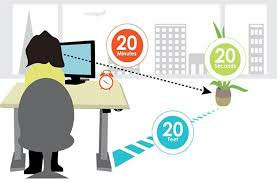SPENDING long periods looking at computer, phone, or tablet screens can strain the eyes. Using the 20-20-20 rule can help to prevent this problem.
The rule says that for every 20 minutes spent looking at a screen, a person should look at something 20 feet away for 20 seconds.
Following the rule is a great way to remember to take frequent breaks. This should reduce eye strain caused by looking at digital screens for too long.
In this article, we describe how to use the 20-20-20 rule effectively. We also discuss the research behind the rule and other tips for preventing eye strain.
The 20-20-20 rule was designed by Californian optometrist Jeffrey Anshel as an easy reminder to take breaks and prevent eye strain.
The following methods can help a person to put this rule into practice:
• Set an alarm for every 20 minutes while working, as a reminder to take a break.
• Download an app developed to help people follow the 20-20-20 rule. The ProtectYourVision and eyeCare apps are some examples.
• Look out a window during the 20-second breaks. Judging a distance of 20 feet inside can be difficult, but focusing on a tree or lamppost across the street should work well.
Alternately, a person can benefit from closing their eyes for 20 seconds every 20 minutes. Also, remembering to blink can prevent dry eye by encouraging tear production.
Anyone who spends the day sitting should periodically get up and walk around, to prevent back and neck pains.
Little scientific research has tested the effectiveness of the 20-20-20 rule, but both the American Optometric Association and the American Academy of Ophthalmology recommend it as a way to reduce eye strain.
Results of a 2013 study involving 795 university students suggested that those who periodically refocused on distant objects while using the computer had fewer symptoms of computer vision syndrome, which include eye strain, watering or dry eyes, and blurred vision.
Several symptoms can indicate eye strain, including:
• eye watering
• blurred vision
• dry eyes
• headaches
• eye redness
Sitting in the same position for a long time has other harmful effects on the body. For example, it can cause neck, back, or shoulder pain.









